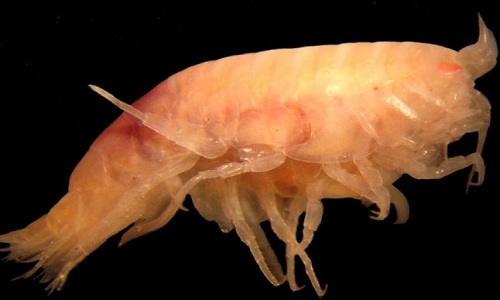Discovered two new marine shrimp species specializing in eating whale carcasses
Researchers in the UK have discovered two new species of two-legged armor (amchipod) that specialize in eating whale carcasses.
Sea shrimp specializes in eating whale carcasses
UPI reported yesterday that researchers at the National Oceanographic Center, Southampton, England, have discovered two new species of marine creatures that look like shrimp. They were discovered in the south-west waters of Ireland, in the trap of ready-placed mackerel placed below 4,800 meters below sea level.

A close-up look at the shape of a marine creature belonging to the Paracallisoma family has just been discovered.(Photo: National Oceanographic Center.)
When the team recaptured the cage trap, they found 40,000 crustaceans belonging to 9,500 species, including two new species belonging to the family Haptocallisoma and Paracallisoma.
Crustaceans are the main source of whale food. But when whales die and sink to the bottom of the sea, they become prey to crustaceans. Similar to land-based maggots , small crustaceans in the amphipod group help clear decomposing meat on the seabed.
Like other amphipod species, newly discovered creatures also eat scavengers of marine animals such as whales. They can eat the dead body of a pig within a few days.
"The group of two-legged crustaceans is extremely rich and adaptable; there are currently about 10,000 known species. They live in all marine environments, from shallow waters to the deepest trenches below seabed, on land and in fresh water , "said researcher Tammy Horton.
- Whale carcasses the US coast
- Why does the whale's body explode?
- Close up of sharks tearing the giant whale in the middle of the surfing area
- Why are whales still useful until they die?
- Shrimp gnaw on the wreck of the sea
- Shrimp turns into a
- The world's most bizarre green shrimp
- The hero scene dealt with the giant humpback whale
- Video: The whale's body suddenly exploded
- Tiny shrimp species can save the Earth before climate change
- Detecting strange colorful shrimp
- Shrimp species can live in hot water of 450 degrees Celsius
 Surprised: Fish that live in the dark ocean still see colors
Surprised: Fish that live in the dark ocean still see colors Japan suddenly caught the creature that caused the earthquake in the legend
Japan suddenly caught the creature that caused the earthquake in the legend A series of gray whale carcasses washed ashore on California's coast
A series of gray whale carcasses washed ashore on California's coast Compare the size of shark species in the world
Compare the size of shark species in the world